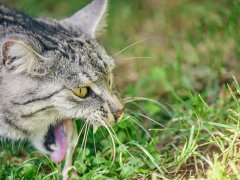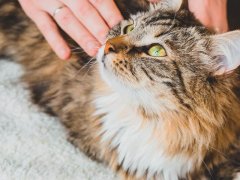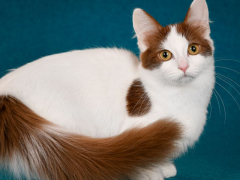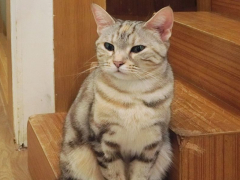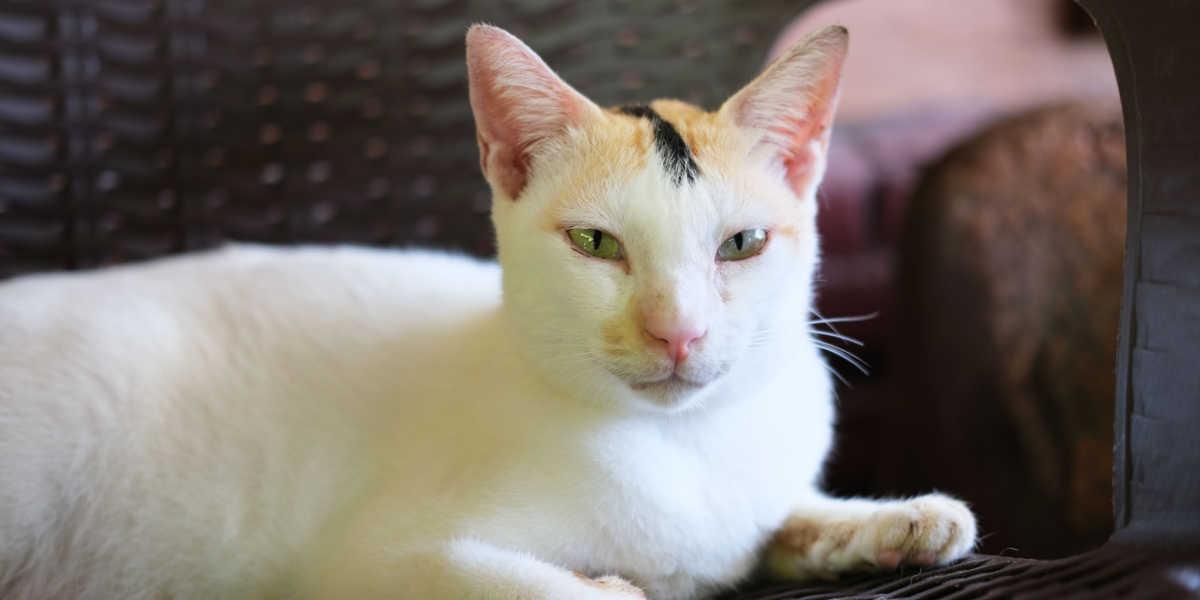
Seeing your cat’s eye swollen is an understandably alarming thing. As a concerned cat owner, you probably not only wonder how your cat’s eye got to be that way, but if it’s serious, and how to help fix it.
A swollen eye could mean that your cat is experiencing one of a number of medical conditions. In this article, you’ll learn some causes of a swollen eye in a cat, how your vet can determine the cause, treatment options, and explore some frequently asked questions.
What Parts of the Eye Swell in a Cat?
It is hard for a vet to know what caused your cat’s swollen eye without examining the eye. It is still helpful to provide an accurate description of the swelling when calling your vet for advice.
There are four main parts of the eye that can swell.
- Conjunctiva – Swelling of the conjunctiva, or conjunctivitis, is the most commonly reported cause of eye swelling in cats. The conjunctiva is a membrane that protects the eye. It covers the white part of the eye (sclera) and the underside of the upper and lower eyelids. The third eyelid of the cat, or nictitating membrane is also covered by conjunctival tissue.
- Eyelids – While not part of the eye itself, the eyelids are connected to the eye through tissue membranes. When the eyelids swell, this is called blepharitis. Blepharitis can give the appearance of a swollen eye though the eye itself may not be affected.
- Inside the Eye – The inside of the eye is filled with a fluid called aqueous humor. Too much of this fluid inside the eye can cause increased pressure, sometimes leading to visible enlargement of the eye itself.
- Behind the Eye – While not part of the eye itself, any kind of swelling in the space behind the eye, which is called the retro-orbital space, can cause the eye to protrude and appear irritated.
Possible Causes if Your Cat’s Eye Is Swollen
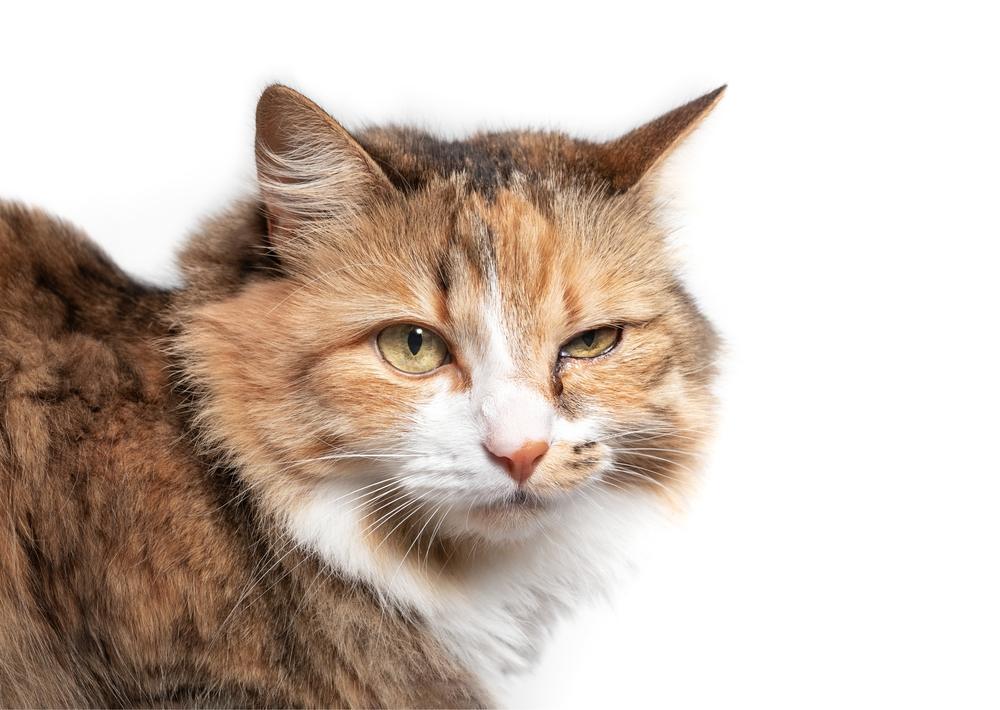
Some types of infections of the eye are accompanied by discharge.
Next, let’s look at these types of swelling of the eye in cats and some underlying causes for each.
1. Conjunctivitis
Conjunctivitis is the most common reason a cat owner will call the veterinarian about a swollen eye. This condition involves swelling of the soft pink tissues beneath the eyelids. The white part of the eye may also develop redness. This appearance is why conjunctivitis is sometimes called “pinkeye.”
Pinkeye is often accompanied by signs of squinting as well as discharge from the eye. Discharge may be watery or develop into a thicker yellow, green, or white material.
Conjunctivitis has four main causes:
- Bacterial – Bacterial infection is the most common cause of conjunctivitis. Introduced bacteria collect and overgrow beneath the lids. Trauma and inflammation of the eye may also lead to a secondary bacterial infection.
- Viral – Viral infections like feline herpesvirus can contribute to conjunctivitis. This is especially true in young kittens and cats who are under stress and have compromised immune function.
- Allergic – Allergens like pollen lead to swelling of the conjunctiva from the body’s reaction to them.
- Trauma – If the underside of the lids or surface of the eye is injured, especially by another cat’s nail during a fight, the swelling often leads to conjunctivitis. Secondary bacterial infection is also common. Trauma most often only affects one eye while other causes typically affect both eyes.
2. Blepharitis
Blepharitis, or swelling/inflammation of the eyelids, also has several causes.
- Trauma – A cat scratch or other cut or scrape on the eye will lead to inflammation and swelling.
- Infection – Wounds on the eyelid easily lead to infection. The eyelids can also develop bacterial infection of the glands that line them, leading to swelling.
- Eyelid Abnormalities – Some cats are born with inherited abnormalities of the eyelids. The most common is called entropion, where the eyelids are turned inwards, leading to inflammation from the fur and eyelashes rubbing on the eye surface. This is more common in cat breeds like Persians and Himalayans with flatter faces and skin folds beneath their eyes.
- Eyelid Growths Or Tumors: any kind of tumor or growth on the eyelid can cause irritation and swelling. Most often, these develop from the glands lining the eyelid.
3. Glaucoma
Glaucoma is caused by increased pressure within the eye itself, which then leads to a swollen, enlarged, and painful eye. In all cases, increased pressure is caused by poor drainage of the aqueous humor fluid inside the eye, which builds up.
Glaucoma can be very serious, as the increased pressure compresses the optic nerve at the back of the eye, affecting vision. It has a few common causes:
- Inherited – This form of glaucoma is rare but most often occurs in Siamese and Burmese cats, who can genetically have the disease.
- Uveitis – Uveitis is the term for generalized inflammation within the eye. There are many causes of uveitis including viral, bacterial, and parasitic infections, immune disorders, and cancer.
- Bleeding inside the eye – Blood accumulation and clots will block the outflow of aqueous humor. This can occur from trauma, but also from diseases that cause very high blood pressure, like kidney disease, heart disease, and hyperthyroidism.
- Lens Damage – The eye lens can be damaged or dislocated from trauma or uveitis.
- Tumors – While uncommon, tumors occurring within the eye itself will disrupt normal aqueous humor flow.
4. Behind the Eye
Swelling occurring behind the eye most often results from infection causing an abscess, or from a tumor or growth pushing the eye outwards. Outdoor cats or kitties in multi-cat households are more predisposed to abscesses behind the eye due to fighting and trauma.
The third eyelid, or nictitating membrane, is the layer of tissue beneath the lid that you may sometimes see covering part of the eye. It is often more noticeable when a cat is experiencing eye pain, as one of its jobs is to protect the eye. The third eyelid also has a gland that may prolapse, or pop out of place. This is uncommon in cats but is seen more often in the Burmese breed.
Also Read: Cat Eye Infections: Causes, Symptoms, & Treatment
When To Call the Vet

A vet will likely need to see a cat’s swollen eye in person in order to give the correct diagnosis.
Any appearance of the eye consistent with swelling, regardless of what part of the eye is affected, should be evaluated by your veterinarian. It may not always be clear at home what part of the eye is affected or how serious it is, especially if your cat is in pain and won’t allow you to get a good look at it.
Some eye disorders, if not treated promptly, may lead to permanent changes in vision, or vision loss altogether. This is especially the case with glaucoma and scratches or trauma to the surface of the eye.
Treating Eye Swelling in Cats
Your veterinarian will first determine what part of the eye is affected, aided with the use of a lighted ophthalmoscope. There are then certain tests that may be performed to assess the status of the eye or confirm a disease.
- Schirmer tear test – This test checks for proper tear production. Decreased tear production can cause inflammation, swelling, and discharge from the eye when it is not being lubricated properly.
- Fluorescein dye/stain – This test looks for scratches or ulcerations on the surface of the eye. These can occur with trauma and viral or bacterial infection.
- Intraocular pressure (IOP) – This test uses an instrument called a tonometer to check the pressures inside the eye. It is also used to screen for both increased pressure from glaucoma as well as decreased pressure from inflammation.
X-rays may be used to evaluate swelling behind the eye. Bloodwork is often recommended if uveitis is suspected to see if an underlying cause affecting the body can be found.
Depending on the cause, your vet may choose one or more of the following treatments:
- Eye drops – Anti-inflammatory drops, antibiotic drops, or a combination of both can be used to address inflammation and infection, especially in the case of conjunctivitis or blepharitis. Different eyedrops are used for glaucoma to help reduce pressure inside the eye.
- Oral medication – Underlying causes of uveitis, blepharitis, and glaucoma may require use of oral antibiotics, anti-inflammatories, pain medication, and others.
- Surgery – Surgery may be considered for eyelid growths, addressing open wounds, or for correcting an inherited eyelid disorder like entropion. A prolapsed or popped-out third eyelid gland can be replaced beneath the eyelid with surgery.
Home Care Treatment Options
If your cat’s eye is swollen, it is helpful to apply a warm compress. A washcloth run under warm to hot water (but not too hot for your own skin) will reduce swelling and remove discharge from around the eye. If there is little to no improvement within 24 hours of using a compress, a veterinary visit is needed.
If you have any eye drops at home, perhaps from a previous eye issue your cat had, it is best not to use them unless your veterinarian advises you to. Some types of eye drops may cause harm to the eye if improperly used or may be ineffective. Many eye conditions resemble each other and there is no guarantee that your cat has the same condition as before.
If your cat is pawing or rubbing at an affected eye, the use of an Elizabethan collar (“the cone”) will help keep your cat from causing further trauma to the eye.
Prevention of a Swollen Eye in Cats
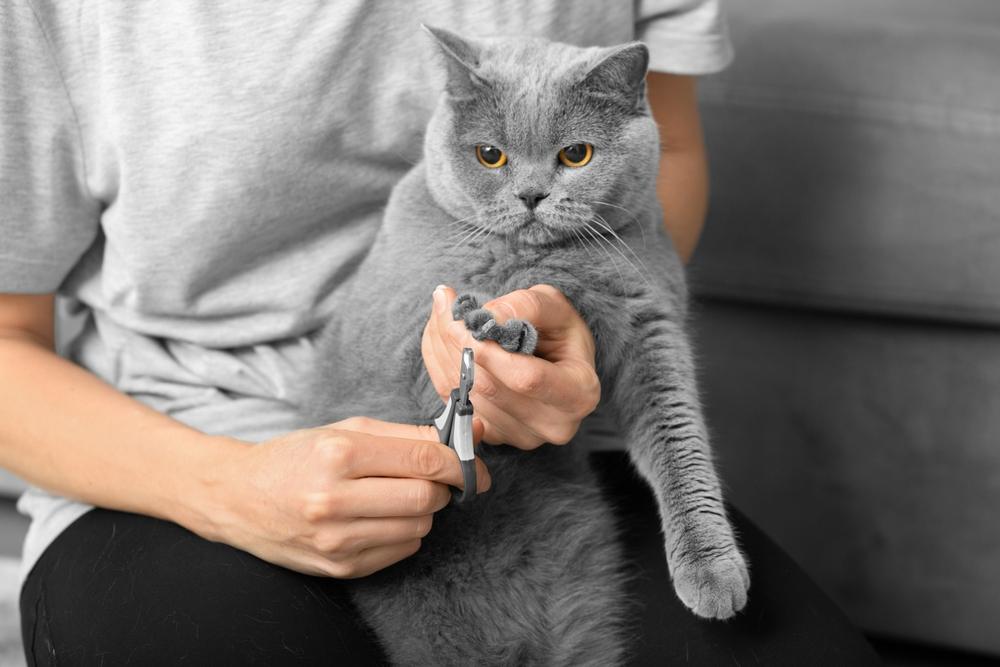
A wounded eye can lead to swelling and infection – so it’s best to keep a cat’s claws clipped down.
Trauma and infection are very common causes of eye swelling in cats. Keep your cats’ nails trimmed short to lessen the chance of a puncture, cut, or scrape on the eye or lids. Outdoor cats will be at more risk for these types of injuries.
Regular preventive health care with your veterinarian every year, or twice a year for older cats, can help detect underlying health issues before they become worse. This includes underlying diseases that contribute to eye inflammation or swelling that could be detected with blood work and blood pressure screening.
Not all eye swelling conditions are preventable, but early detection often makes the difference between a condition that is easier to treat and resolve versus a condition causing permanent damage or blindness.
Final Thoughts
If you see your cat’s eye swollen, there can be many different causes depending on the part of the eye affected. Any cause of eye swelling should be evaluated by a veterinarian as soon as possible. Many disorders causing eye swelling can be treated or managed with early detection and treatment.
Also Read: Do Cats Cry Tears When Sad Or In Pain?
-
Brooks, W. Herpes Viral Conjunctivitis: A Feline Problem. Veterinary Partner. Revised/Reviewed 9/14/2021. Accessed 5/11/2023. https://veterinarypartner.vin.com/default.aspx?pid=19239&id=4951824
-
Cornell Feline Health Center, College of Veterinary Medicine. Feline Glaucoma. Accessed 5/11/2023. https://www.vet.cornell.edu/departments-centers-and-institutes/cornell-feline-health-center/health-information/feline-health-topics/feline-glaucoma
-
Johnson, T. Allergic Conjunctivitis in Dogs and Cats. Veterinary Partner. Published 10/13/2021. Accessed 5/11/2023. https://veterinarypartner.vin.com/default.aspx?pid=19239&id=10517463
-
Millichamp, NJ. Ocular diseases unique to the feline patient (Proceedings). Published 8/01/2010. Accessed 5/11/2023. https://www.dvm360.com/view/ocular-diseases-unique-feline-patient-proceedings
-
Ofri, R. Feline conjunctivitis: A cat is not a small dog! DVM360. Published 12/15/2021. Accessed 5/11/2023. https://www.dvm360.com/view/feline-conjunctivitis-a-cat-is-not-a-small-dog-
-
Radhakrishnan, S. Bacterial Conjunctivitis in Cats. Veterinary Partner. Published 8/27/2021. Accessed 5/11/2023. https://veterinarypartner.vin.com/default.aspx?pid=19239&id=10441962
-
Ramsey, DT. Conditions of the Eyelids and Ocular Adnexa of Dogs and Cats. Waltham/OSU Symposium, Small Animal Ophthalmology, 2001. Accessed through Veterinary Information Network 5/11/2023. https://www.vin.com/apputil/project/defaultadv1.aspx?pid=11132&catid=&id=3844149&meta=&authorid=
-
Weir, M, Hunter, T, and Yuill, C. Blepharitis in Cats. VCA Animal Hospitals. Accessed 5/11/2023. https://vcahospitals.com/know-your-pet/blepharitis-in-cats
-
Williams, K, Hunter, T, Yuill, C. Glaucoma in Cats. VCA Animal Hospitals. Accessed 5/11/2023. https://vcahospitals.com/know-your-pet/glaucoma-in-cats
